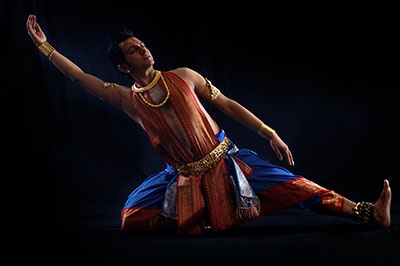Satvika - Forms of the Formless
NASDA Theatre, E Block, CPIT, Christchurch
05/10/2012 - 07/10/2012
Whitireia Performance Centre, 25-27 Vivian Street, Wellington
25/05/2013 - 26/05/2013
Production Details
SATVIKA
Exotic stories of the romances and battles of Hindu Gods and Goddesses. Internationally renowned Wellington based dancer / choreographer Vivek Kinra and Mudra Dance Company present a vibrant dance extravaganza. The dynamic dance work of ‘Satvika’ is a kaleidoscope of motion, colour, music, mime and rhythmm comprising a wide range of dances.
‘Satvika’ showcases Kinra’s choregraphy, which combines traditional and innovative elements of dance. The stories of these dances are based on the philosophies of life. Through the battles and romances of the Hindu gods and goddesses, the darkness is dispersed and the righteous mode of living is portrayed.
Characterised by exotic beauty and charm, Mudra Dance Company is a visual feast of brilliant sari colours, traditional headdresses of braids and flowers and the sparkle of gorgeous jewellery. Vivek Kinra and Mudra Dance Company promise to enthrall their audience with the scintillating and exuberant dance experience of ‘Satvika’.
Company Vivek Kinra and Mudra Dance Company
2 hrs incl intermission of 15 mins
Mutable and marvellous
Review by Jennifer Shennan 26th May 2013
Copyright © in the review belongs to the reviewer
Joyous craftsmanship
Review by Toby Behan 06th Oct 2012
After a three-year absence from the Body Festival, Vivek Kinra made a welcome return to the stage last night with the Mudra Dance Company, performing Satvika: Forms of the Formless to a capacity house at the modest NASDA Theatre. The audience was provided with a joy to the senses – beginning with the distinctive smell of incense as the stage is approached. From there, the colour, light, music, costumes, rhythm and dance proved captivating.
Kinra himself is a hugely accomplished performer and commands the eye when he takes the stage. He is thoroughly schooled in the roots of his art-form. Bharata-Natyam is a classical Indian dance form – a form of which this reviewer had seen little of beforehand, but which is so compelling in its purity and theatricality that it literally compels one to Google. The definition of Bharata-Natyam is itself perhaps sufficient as a taster for the background of the art-form. The name depicts it as ‘Bha’ (expression), ‘Ra’ (music), ‘T’ (‘talam’ – beat, or rhythm) and ‘Natyam’ (dance). The combination of these elements was a joy to behold last night and a refreshingly honest expression of celebratory dance.
Satvika has as its subtitle ‘Tales of the Romances and Battles of Hindu Gods and Goddesses’. The performance is therefore composed of various dances, each composed around a different Hindu deity with distinctive stylized differences. The majority of the pieces are performed by company dancers Radhika Patel and Anuksha Narayan, as well as by Kinra himself, and a lovely touch allows local Christchurch Bharatanatyam teacher Anuradha Ambalavanar to perform in two pieces, as well as some senior dancers from her Christchurch-based Bharatanatyam group, who open the evening’s performance. With all performers wearing traditional costumes, resplendent with colour and bells on their ankles, the overall impression is one of joyous craftsmanship.
The dancers are well-disciplined, and not simply with the physical coordination and athleticism we have come to expect from (for example) ballet and contemporary dance. Watch closely and marvel at the precision of every finger placement and the incredible importance these have in the sculptural form of movement. The eyes and head come to the fore far more than in most other dance styles, and the complicated rhythms (with a lot of foot-stamping and the accompanying jingles from the bells on ankles) are so precisely done. Any dancers who have not seen this form of dance before will be amazed at the discipline involved – if you have not seen the Mudra Dance Company before – make it a point to go.
There are two mighty solos performed by Kinra, with titles almost as demanding as the physical workload each necessitates. Shivapanchaksharastotram is the central piece of the evening, a salutation to Lord Shiva, which features Kinra’s wonderful range of facial expressions, rhythmic precision and theatricality. The (slightly) more dark and sedate Thiruppugarh is an equally compelling solo, allowing us to catch our breath after witnessing a precise trio from Patel, Narayan and Ambalavanar. Patel and Narayan shoulder most of the workload (and they are both beautiful artists with precision and poise) for the performance, appearing in seven of the ten pieces and never flagging – their dance technique and performance commitment are wonderful to behold.
Many of the ten pieces begin with a narrated opening, with Kinra onstage echoing the spoken words with an effortless series of gestures and poses which reinforce what is being said. The overall effect is like those fancy storybooks we read as children, where the first page of a chapter features a giant and beautiful illustration which hints at what is to come. Indeed, this concept of a storybook is somewhat apt for a description of the performance itself, as so many of the movements and poses are reminiscent of those which we would see from traditional Indian paintings.
It would be good to see more of the larger ensemble numbers on stage, as the spectacle would simply be increased. The duets and solos are wonderful to watch, but with the majority of the pieces featuring three performers or less (and always the same performers) – it becomes harder to accept the diversity that each of the choreographies hold.
Kinra notes in the programme that he is in ‘the twilight of his performance career’. With such a distinguished and talented choreographer and artist performing, please do ensure that you see him before that twilight ends.
Copyright © in the review belongs to the reviewer
Comments
Make a comment
You must be logged in to post a comment.
Make a comment
You must be logged in to post a comment.





Comments